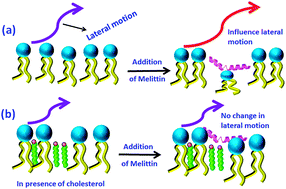Effect of antimicrobial peptide on the dynamics of phosphocholine membrane: role of cholesterol and physical state of bilayer†
Abstract
Antimicrobial peptides are universal in all forms of life and are well known for their strong interaction with the cell membrane. This makes them a popular target for investigation of peptide–lipid interactions. Here we report the effect of melittin, an important antimicrobial peptide, on the dynamics of membranes based on 1,2-dimyristoyl-sn-glycero-3-phosphocholine (DMPC) lipid in both the solid gel and fluid phases. To probe the phase transition, elastic neutron intensity temperature scans have been carried out on DMPC-based unilamellar vesicles (ULV) with and without melittin. We have found that addition of a small amount (0.2 mol%) melittin eliminates the steep fall in the elastic intensity at 296 K associated with the solid gel to fluid phase transition, which is observed for pure DMPC vesicles. Quasielastic neutron scattering (QENS) experiments have been carried out on DMPC ULV in the solid gel and fluid phases with and without 0.2 mol% melittin. The data analysis invariably shows the presence of lateral and internal motions of the DMPC molecule. We found that melittin does have a profound effect on the dynamics of lipid molecules, especially on the lateral motion, and affects it in a different way, depending on the phase of the bilayers. In the solid gel phase, it acts as a plasticizer, enhancing the lateral motion of DMPC. However, in the fluid phase it acts as a stiffening agent, restricting the lateral motion of the lipid molecules. These observations are consistent with the mean squared displacements extracted from the elastic intensity temperature scans. Their importance lies in the fact that many membrane processes, including signaling and energy transduction pathways, are controlled to a great extent by the lateral diffusion of lipids in the membrane. To investigate the effect of melittin on vesicles supplemented with cholesterol, QENS experiments have also been carried out on DMPC ULV with cholesterol in the presence and absence of 0.2 mol% melittin. Remarkably, the effects of melittin on the membrane dynamics disappear in the presence of 20 mol% cholesterol. Our measurements indicate that the destabilizing effect of the peptide melittin on membranes can be mitigated by the presence of cholesterol. This study might provide new insights into the mechanism of action of antimicrobial peptides and their selective toxicity towards foreign microorganisms.


 Please wait while we load your content...
Please wait while we load your content...